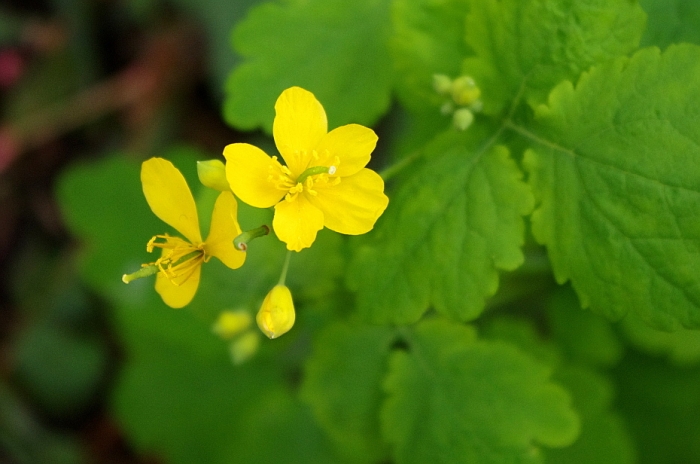Greater Celandine
(Chelidonium majus)
Greater Celandine (Chelidonium majus)
/
/

Георгий Виноградов (Georgy Vinogradov)
CC BY 4.0
Image By:
Георгий Виноградов (Georgy Vinogradov)
Recorded By:
Copyright:
CC BY 4.0
Copyright Notice:
Photo by: Георгий Виноградов (Georgy Vinogradov) | License Type: CC BY 4.0 | License URL: http://creativecommons.org/licenses/by/4.0/ | Rights Holder: Георгий Виноградов (Georgy Vinogradov) | Publisher: iNaturalist | Date Created: 2021-10-02T16:07:11-07:00 |























Estimated Native Range
Summary
Chelidonium majus, commonly known as greater celandine, is a perennial herb that is native to Europe and western Asia. It has been introduced widely in North America, where it often grows in disturbed areas such as roadsides and waste places, as well as in the understory of deciduous forests. Greater celandine typically reaches a height of 12-47 inches (30-120 cm). The plant is characterized by its blue-green, pinnate leaves and distinctive yellow latex that exudes from the stems when they are broken. It produces bright yellow flowers from May to September, which are arranged in small, umbrella-like clusters known as umbelliform cymes. The flowers are moderately showy and attract various pollinators.
Greater celandine is valued for its ornamental flowers and has been used traditionally in herbal medicine. It is often found in herb gardens and naturalized areas. In cultivation, it prefers partial shade to full sun, moist but well-drained soils, and can tolerate a range of soil types. While it is relatively low maintenance, it can spread aggressively by self-seeding and may become weedy in favorable conditions. Gardeners should be cautious of its potential invasiveness, especially when planting it outside of its native range. It is important to check local regulations before growing greater celandine, as it is considered invasive in some regions.CC BY-SA 4.0
Greater celandine is valued for its ornamental flowers and has been used traditionally in herbal medicine. It is often found in herb gardens and naturalized areas. In cultivation, it prefers partial shade to full sun, moist but well-drained soils, and can tolerate a range of soil types. While it is relatively low maintenance, it can spread aggressively by self-seeding and may become weedy in favorable conditions. Gardeners should be cautious of its potential invasiveness, especially when planting it outside of its native range. It is important to check local regulations before growing greater celandine, as it is considered invasive in some regions.CC BY-SA 4.0
Plant Description
- Plant Type: Herb
- Height: 1-2 feet
- Width: 0.6-1 feet
- Growth Rate: Rapid
- Flower Color: Yellow
- Flowering Season: Spring, Summer, Fall
- Leaf Retention: Deciduous
Growth Requirements
- Sun: Full Sun, Part Shade
- Water: Medium
- Drainage: Medium, Slow
Common Uses
Bird Garden, Butterfly Garden, Edible*Disclaimer: Easyscape's listed plant edibility is for informational use. Always verify the safety and proper identification of any plant before consumption., Low Maintenance
Natural Habitat
Native to Europe and western Asia, often found in disturbed areas and the understory of deciduous forests
Other Names
Common Names: Tetterwort, Swallow Wort
Scientific Names: , Chelidonium majus, Chelidonium cavaleriei, Chelidonium dahuricum, Chelidonium grandiflorum, Chelidonium haematodes, Chelidonium laciniatum, Chelidonium luteum, Chelidonium majus f. acutilobum, Chelidonium majus f. claputiense
GBIF Accepted Name: